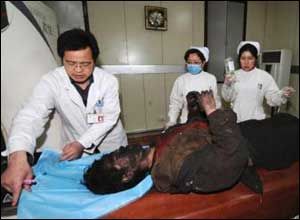Monterey County Herald, The Associated Press
 AP Photo/Xinhua, Yan Yan In this photo released by the official Xinhua news agency, medical employees check a wounded miner at a hospital in Gujiao city in China’s Shanxi province, Sunday. A gas explosion ripped through a coal mine in northern China on Sunday, killing at least 73 miners and trapping dozens in the still-burning shaft, state media said. |
GUJIAO, China — Rescuers wearing headlamps and oxygen backpacks carried dozens of miners to safety Sunday after a gas explosion at a coal mine in northern China killed at least 74.
The blast at the mine, which had for years boasted an exemplary safety record, highlighted the perilous conditions that make China’s mining industry the deadliest in the world.
Survivors described how they tried to flee along tunnels to escape the choking carbon monoxide, but were overcome by the fumes.
“When it happened, I felt a big gust of wind that blew me over,” a miner with tubes coming out of his nose told state broadcaster CCTV from his hospital bed. “I got up and started running to try to get to the surface. After that I don’t know what happened.” His name was not given.
The official Xinhua News Agency said 436 miners were in the Tunlan Coal Mine in Gujiao city near Taiyuan, the capital of Shanxi province, when the pre-dawn blast occurred.
At least 74 miners died and 114 others were hospitalized, including six in critical condition, Xinhua said, making it China’s deadliest mine disaster in more than a year.
All the miners who had been trapped underground were found by late Sunday, Xinhua said, citing the rescue headquarters. It was not clear if all the bodies had been recovered.
One survivor, Xue Huancheng, told Xinhua from his hospital bed that he remembered being ordered to flee because the ventilation system had broken down.
“Power supply underground was cut off and we had to walk,” he said.
Even though he was using an oxygen tank to help him breathe, Xue said he fainted after walking for 40 minutes, just as he neared the exit. He awoke two hours later in a hospital.
Most of the injured miners were suffering from carbon monoxide poisoning, Xinhua said, citing doctors. Exposure to carbon monoxide, an odorless, colorless gas, can cause headaches, dizziness, nausea and may lead to death.
The mine is owned by Shanxi Coking Coal Group, China’s largest producer of coking coal, which is used in the production of steel. The company said it is the world’s second-largest coking coal producer, with sales revenues that topped 37 billion yuan ($5.4 billion) in 2007. Xinhua said it operated 28 mines.
Xinhua said Tunlan Coal Mine had among the best facilities of any mine in China and that no major accidents had occurred there in five years. The mine produces 5 million tons of coking coal a year.
A State Administration of Work Safety duty officer who would give only her surname, Zhang, said the cause of the explosion was being investigated.
Rescuers with backpacks attached to breathing equipment and wearing red helmets with headlamps, their faces blackened from the mine, emerged above ground from an elevator to the pit and carried miners on stretchers to waiting ambulances. Some 80 rescuers were deployed, Xinhua said.
The death toll was the highest from a coal mine accident in China since December 2007, when gas exploded in an unventilated tunnel in Linfen city, also in Shanxi province, killing 105 miners, according to the State Administration of Work Safety.
Beijing has promised for years to improve mine safety, but energy-hungry China depends on coal for most of its power.
More than 1,000 dangerous small mines were closed last year, but China’s mining industry remains the world’s deadliest. About 3,200 people died in coal mine accidents last year, a 15 percent decline from the previous year.
While China’s overall coal mining safety record is abysmal, the numbers mask great disparities. Large, state-run mines tend to have safety records approaching those of developed countries while smaller mines have little or no safety equipment and weak worker training.
Government figures show that almost 80 percent of China’s 16,000 mines are small, illegal operations.
Associated Press writer Gillian Wong contributed to this report from Beijing.











